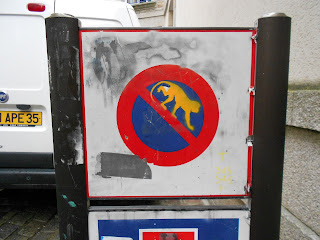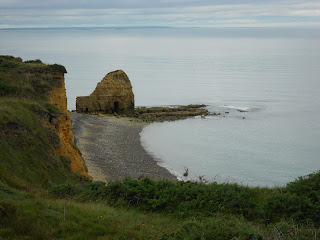After Paris was Normandy. On our way there, we visited a church, and got a tour by the cutest old man tour guide in the world. We each had special headsets that were somehow magically connected to his microphone, so when he talked quietly, we could all hear it loudly in our ears. His English was rough, but he clearly loved the church, and kept making awkward jokes that only he would laugh at. And I don't think he understood the correct definition of "bitches", because he used it as a synonym for "prostitutes". Twice. I listened intently to his words, but I found out later that about 5 seconds into the recorded tour, Tissy found a way to switch channels to the Chinese tour, and spent her time changing everyone elses'. After the Cathedral of Chartres we left for Sant Malo, our first beach town. Unfortunately, it was like 50 degrees out, so swimming wasn't really an option. But the town was quaint, and we got some free time to walk the streets and do some shopping.
(Quick side note. While the Europeans have no problem staying out clubbing until 6am, apparently all the shopkeepers or winkliers have a strict, old-lady bedtime of 7:30, and close every store and restaurant at 7. It's quite inconvenient.)
Sant Malo was fun, but it definitely was not a bar town. That night we all decided to go out to this little Irish pub around the corner, but when we got there, it was dead. Our modest group of 17 outnumbered the patrons by 17 to 1. Including the bartender. So we walked up to the high wall surrounding the entire town, and looked out at the tide. The next day we went to le Mont-Saint-Michel, which is a (you guessed it, another church) that was pretty much built in the middle of a swamp. With quicksand. Dr. Hughes actually warned us against going out into the sand/swamp area, because people have gotten sucked up by quicksand. Hmm, cool.
The next day was our last day in France, and we woke up at the crack of dawn for breakfast and left for Bayaux. (Another side note: free breakfasts are awesome. Great perk, especially for someone, like me, who doesn't normally eat breakfast. When it's free, I'll eat it. Plus France always has croissants for breakfast. Heavenly.) Bayaux is home to the Bayaux Tapestry, a 70 meter long tapestry portraying the Norman invasion. I really liked this part, and I thought it was amazing that someone was able to stitch every little detail in the tapestry. The tour was good too, because it was individual headsets telling the story in the tapestry piece by piece. I could go at my own pace, and pause the recording when I wanted to spend time just looking. Sometimes I feel rushed on these tours, and I don't get the chance to just stop and look. I understand that we want to see a lot in a short amount of time, but sometimes I just want to walk at my own pace, and see things my way.
After the Bayaux Tapestry we went to Arromanches, where the D-Day Invasion Beach and Museum was. We started at Pointe du Hoc, a high cliff, where German soldiers set up base during World War II. shooting down at the Army's 2nd Ranger Battalion landed at a beach below. A few weeks before I left for Belgium, I had been flipping channels, and landed on the History Channel. They were doing a story about Pointe du Hoc, and I was sucked in. It was a fascinating story. The Germans thought that they were safe up on the cliff, because it was so high that it seemed impossible to climb. But the Americans were determined and a little crazy, because they charged the cliffs anyway, even while enemy fire rained down on them. American ships helped a little, by bombing the top of the cliff. We saw the huge craters that the bombs left. It was incredible. We got to walk inside a German bunker, and saw what was left of the guns. I was walking on history.
After Pointe du Hoc we went to Omaha Beach and saw the American Cemetery there. The cemetery went on for days, just rows and rows of white crosses. Although I don't know of any relatives that fought in World War II, my heart went out to the thousands of soldiers who lost their lives fighting for freedom.
The Normandy American Cemetery and Memorial in France is located on the site of the temporary American St. Laurent Cemetery, established by the U.S. First Army on June 8, 1944 and the first American cemetery on European soil in World War II. The cemetery site, at the north end of its ½ mile access road, covers 172.5 acres and contains the graves of 9,387 of our military dead, most of whom lost their lives in the D-Day landings and ensuing operations. On the Walls of the Missing in a semicircular garden on the east side of the memorial are inscribed 1,557 names. Rosettes mark the names of those since recovered and identified.
The memorial consists of a semicircular colonnade with a loggia at each end containing large maps and narratives of the military operations; at the center is the bronze statue, "Spirit of American Youth." An orientation table overlooking the beach depicts the landings in Normandy. Facing west at the memorial, one sees in the foreground the reflecting pool; beyond is the burial area with a circular chapel and, at the far end, granite statues representing the U.S. and France.
The cemetery is open to the public daily except on December 25 and January 1. Hours of operation are 9 a.m. to 6 p.m. from April 15 to September 15, and 9 a.m. to 5 p.m. the rest of the year. It is open on host country holidays. When the cemetery is open to the public, staff members are on duty in the Visitor Center to answer questions and escort relatives to grave and memorial sites.
That night we had our second dinner paid for by Loyola, and the food was fantastic. I had salad and fish and an apple pastry for dessert. And all the wine we could drink. It was nice to be able to relax with good food and great company, and it was the perfect ending to our France trip. The next morning we packed up our belongings and headed home to Belgium.








No comments:
Post a Comment